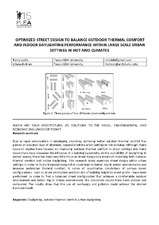| dc.creator | Labib, Rania | |
| dc.creator | Beltran, Liliana | |
| dc.date.accessioned | 2016-08-16T16:31:05Z | |
| dc.date.available | 2016-08-16T16:31:05Z | |
| dc.date.issued | 2015-09 | |
| dc.identifier.uri | https://hdl.handle.net/1969.1/157539 | |
| dc.description.abstract | Due to rapid urbanization in developing countries, achieving better outdoor thermal comfort has
gained an elevated level of attention, especially within urban settings in hot climates. Although many
research studies have focused on improving outdoor thermal comfort in urban settings and many
researchers have discussed the influence of a building’s geometry on the availability of daylighting in
indoor spaces, there has been very little focus on street design as a means of improving both outdoor
thermal comfort and indoor daylighting. This research study examines street design within urban
settings in order to find a balanced design that could lead to better day-lit indoor environments and
improve pedestrian thermal comfort. A series of quantitative simulations of various street
configurations - such as street orientation and the ratio of building height to street width – have been
performed. In order to find a balanced street configuration that achieves a comfortable outdoor
environment and better day-lit indoor environment, the simulation results have been plotted and
compared. The results show that the use of overhangs and galleries could achieve the desired
balanced result. | en |
| dc.publisher | 31th International PLEA Conference | |
| dc.subject | Daylighting | en |
| dc.subject | Thermal Comfort | en |
| dc.subject | Outdoor Thermal Comfort | en |
| dc.subject | Building Performance Simulations | en |
| dc.subject | Glare | en |
| dc.subject | Passive Solar | en |
| dc.title | Optimized Street Design to Balance Outdoor Thermal Comfort And Indoor Daylighting Performance Within Large Scale Urban Settings in Hot Arid Climates. | en |
| dc.type | Article | en |
| local.department | Architecture | en |
| dc.identifier.doi | 10.13140/RG.2.2.36109.54242 | |


